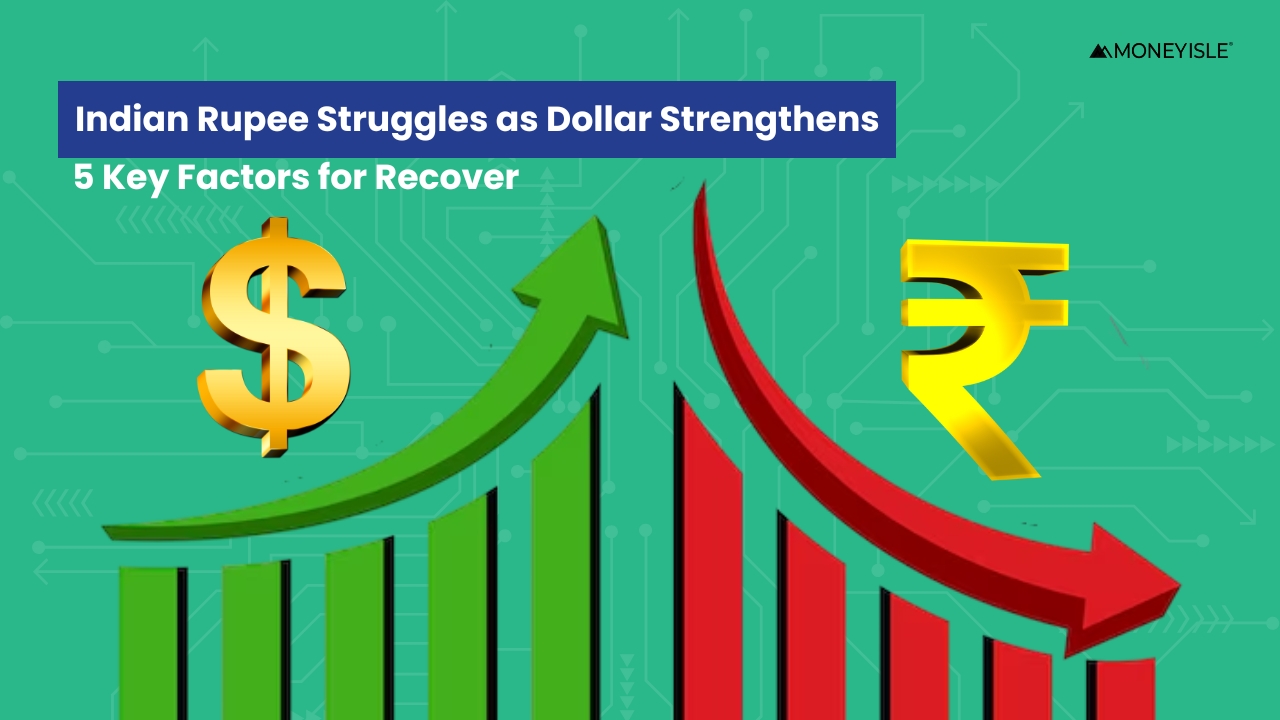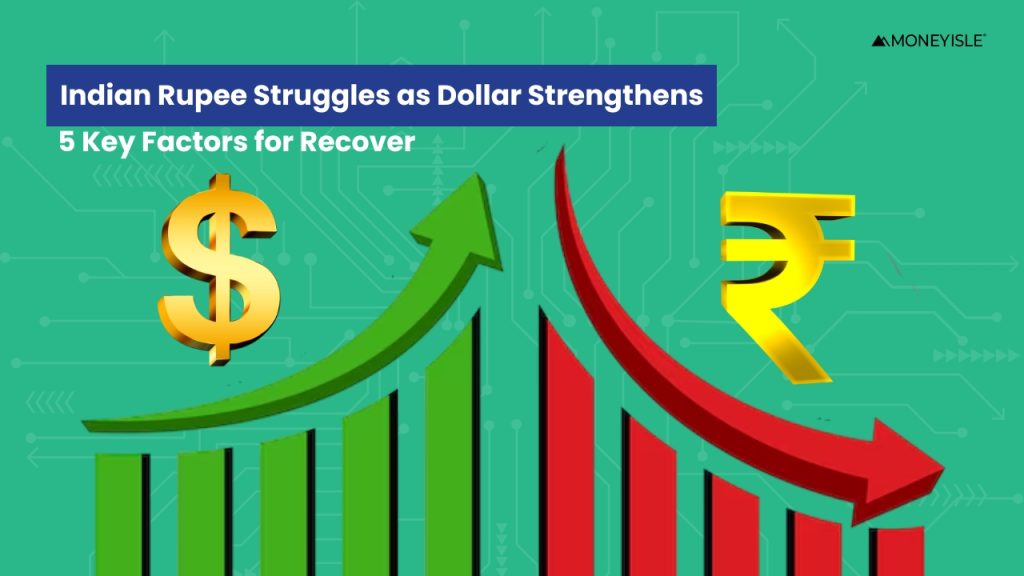The Indian Rupee (INR) continues to struggle as the US Dollar (USD) strengthens, impacting imports, inflation, and investor sentiment. Several key factors contribute to the rupee’s weakness and potential recovery. First, rising US interest rates attract foreign capital to dollar assets, reducing demand for the rupee. Second, trade imbalances due to higher imports than exports weaken India’s forex reserves. Third, global economic uncertainty, including geopolitical tensions and crude oil price fluctuations, increases pressure on emerging market currencies like INR. Fourth, foreign institutional investors (FIIs) withdrawing funds from Indian markets weakens the rupee further. Fifth, RBI’s intervention through forex reserves and monetary policies could stabilize the currency over time. While challenges persist, factors like strong GDP growth, stable policies, and foreign investment inflows can aid the rupee’s recovery. Investors and businesses must stay informed about currency trends and economic policies to navigate market volatility effectively.
1. Why is the Indian Rupee Falling Against the Dollar?
The rupee’s decline against the US dollar is driven by best investment plan in india several domestic and global factors. The following key reasons explain this depreciation:
a) Strengthening of the US Dollar
The US Federal Reserve’s tight monetary policy has led to a stronger dollar. Higher interest rates in the US attract global investors, leading to capital outflows from emerging markets like India. This causes the Indian rupee to weaken.
b) Rising Crude Oil Prices
India imports over 80% of its crude oil, and a rise in global oil prices increases demand for dollars, leading to a weaker rupee. When oil prices rise, India’s trade deficit widens, putting further pressure on the currency.
c) Foreign Portfolio Investors (FPI) Outflows
When foreign investors pull money out of the Indian stock market, they sell rupees and buy dollars, leading to rupee depreciation. Uncertainty in global markets, rising US bond yields, and geopolitical tensions contribute to this trend. Foreign Portfolio Investors (FPI) outflows refer to the withdrawal of investments by foreign investors from a country’s financial markets, typically due to economic uncertainties, geopolitical tensions, policy changes, or global financial conditions. When FPIs pull out their investments, it often leads to market volatility, depreciation of the local currency, and a decline in stock indices. Factors such as rising interest rates in developed economies, inflation concerns, and weak domestic economic growth can trigger these outflows. In emerging markets, FPI withdrawals can significantly impact liquidity and investor sentiment. Governments and central banks often take measures such as policy adjustments, interest rate changes, or foreign exchange interventions to stabilize markets and attract investors. While FPI outflows are a natural part of global financial movements, sustained withdrawals can weaken a country’s economic stability. A balanced approach, including strong economic fundamentals and investor-friendly policies, is crucial to mitigating the impact of FPI outflows on financial markets.
d) Trade Deficit and Current Account Deficit (CAD)
India’s trade deficit has been widening due to higher imports and slower export growth. A larger current account deficit means more dollars are required for trade settlements, which weakens the rupee.
e) Inflation and Economic Growth Concerns
Higher inflation rates in India reduce the purchasing power of the rupee. Slower GDP growth, policy uncertainties, and fiscal deficits can also discourage foreign investment, further impacting the rupee’s strength.
2. Impact of Rupee Depreciation on the Indian Economy
A weaker rupee has both positive and negative effects on various sectors of the economy.
a) Higher Import Costs and Inflation
Since India is heavily dependent on imports like crude oil, electronics, and gold, a weaker rupee makes these products more expensive, leading to inflation. This affects common citizens by increasing the cost of fuel, transportation, and essential goods.
b) Impact on Indian Businesses
Companies that rely on nse imported raw materials face higher production costs, which may lead to higher prices for consumers. However, export-oriented sectors like IT and pharmaceuticals benefit from a weaker rupee as they earn in dollars.
c) Rising Foreign Debt Burden
India’s external debt payments become costlier when the rupee depreciates. This increases the burden on the government and corporate borrowers who have taken loans in dollars.
d) Effects on the Stock Market
A depreciating rupee may lead to foreign investors pulling out funds from the Indian stock market, causing volatility. However, sectors like IT and export-driven industries may gain from a weaker rupee.
3. What Can Be Done to Stabilize the Rupee?
The Indian government and the Reserve Bank of India (RBI) take various measures to stabilize the currency and prevent extreme volatility.
a) RBI Intervention
The RBI sells US dollars from its forex reserves to sip investment plans control excessive depreciation. However, it has limited reserves and needs to balance market interventions carefully.
b) Encouraging Foreign Investment
Policies to attract Foreign Direct Investment (FDI) and boost investor confidence can help bring in more dollar inflows, supporting the rupee.
c) Reducing Import Dependence
India can work towards reducing its dependence on crude oil and electronics imports by promoting domestic production and renewable energy sources.
d) Export Promotion
Boosting Indian exports through trade policies, incentives, and market diversification can help bring more foreign currency into the country, strengthening the rupee.
4. Future Outlook: Will the Rupee Recover?
The future outlook for the Indian Rupee (INR) remains uncertain, but several factors could influence its recovery. While the rupee has weakened due to rising US interest rates, trade imbalances, and global economic uncertainty, its long-term trajectory depends on India’s economic policies and external conditions. The Reserve Bank of India (RBI) plays a crucial role in stabilizing the rupee through forex reserves management, interest rate adjustments, and policy interventions.A key factor in potential recovery is India’s strong GDP growth and increasing foreign direct investment (FDI), which could boost investor confidence and currency stability. Additionally, a decline in crude oil prices—one of India’s largest imports—could reduce the trade deficit and support the rupee. If global inflation cools down, the US Federal Reserve may pause or cut interest rates, making emerging market currencies like the rupee more attractive.However, challenges remain, including geopolitical tensions, fiscal deficits, and capital outflows. To strengthen the rupee, India must enhance exports, attract long-term investments, and maintain prudent monetary policies. While short-term volatility is expected, the rupee has the potential for gradual recovery if macroeconomic fundamentals remain strong and global conditions become favorable. Investors should stay cautious yet optimistic.
Conclusion
The Indian rupee’s struggle against a strengthening US dollar is a result of multiple global and domestic factors. While depreciation poses challenges like inflation and higher import costs, it also provides opportunities for export-driven sectors. As the global economy stabilizes and India implements key reforms, the rupee may find support in the future.For more updates on the Indian stock market, currency movements, and economic trends, stay tuned to MoneyIsle is a leading financial platform dedicated to providing real-time stock market updates, investment insights, and expert trading strategies. We help investors navigate the Indian stock market with detailed analysis of stocks, mutual funds, and trading opportunities. Our platform covers everything from top-performing stocks to brokerage comparisons and market trends, ensuring you make informed financial decisions. Whether you’re a beginner or an experienced trader, MoneyIsle equips you with the right tools, research, and knowledge to grow your investments.











